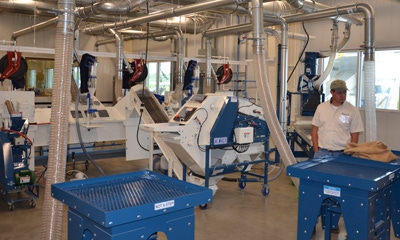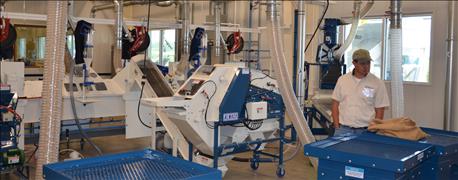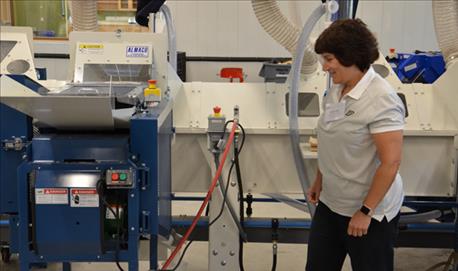
The name says it all. Purdue University has officially opened the Indiana Corn and Soybean Innovation Center, located at Purdue’s Agronomy Center for Research and Education (ACRE) near West Lafayette. The new center is all about one thing when it comes to plants: innovation.
Learn how plants tick through state-of-the-art sensing, both in the sky and on the grounds. Tease out meaningful data from reams of information so researchers and plant breeders can develop tomorrow’s designer plants. Increase efficiency in harvesting and sorting research seed to speed up the discovery process. These are all goals of the new center.
The beginning

PLANT MANAGER’S DREAM: Jason Adams (right) says he’s excited to manage the seed processing lab where machines were designed just for this facility.
Karen Plaut loves to take visitors through the new facility. She can even run one of the 10 individual seed-processing machines in the seed lab by herself. She puts in seed from the field and picks up a bagged sample of that unique seed in a matter of seconds. The seed is ready for storage and further breeding or testing. What once took breeders several valuable minutes in dusty, dank conditions now happens nearly automatically in an environmentally controlled, nearly dust-free environment. And that’s just one part of the center Plaut likes to show visitors.
“This all started when we put together a proposal for President [Mitch] Daniels' Purdue Moves campaign,” explains Plaut, associate dean in Purdue’s College of Agriculture and director of ag research.
“We have a strong presence in agronomic research and plant breeding, and we saw this as the next logical step forward.”

DREAM BECOMES REALITY: What started as a $20 million dream is becoming reality as Purdue University embarks on advanced genetic research in plants, Karen Plaut says.
Plaut oversaw preparation of the plant sciences initiative proposal. It was one of two major proposals accepted, providing $20 million to accelerate plant-related research at Purdue.
From the beginning Plaut knew the goal was to use sensors to collect all kinds of information on plants during the growing season, and then rely on big data techniques to drill down to what would become meaningful information researchers and plant breeders could use to develop more efficient plants and expand the knowledge base related to plant science. Always in the background was the knowledge that there will be 9 billion people to feed by 2050.
Important partners
A major piece of the puzzle was designing and building a state-of-the-art physical structure that would accommodate both those who wanted to collect and sort data, and those who needed space to process and house seed from new research efforts and breeding programs.
“We’re fortunate that other partners joined us in a big way,” Plaut says. The Indiana Soybean Alliance and the Indiana Corn Marketing Council each contributed $2 million in one-time gifts for the project last year. Part of the money went directly to the project, while part of it will fund research projects that occur in the new facility and at ACRE. Other private companies have followed suit, contributing to the effort.
“It’s a world-class program, and now we have a world-class facility,” Plaut says. “We couldn’t be more excited.”
About the Author(s)
You May Also Like




